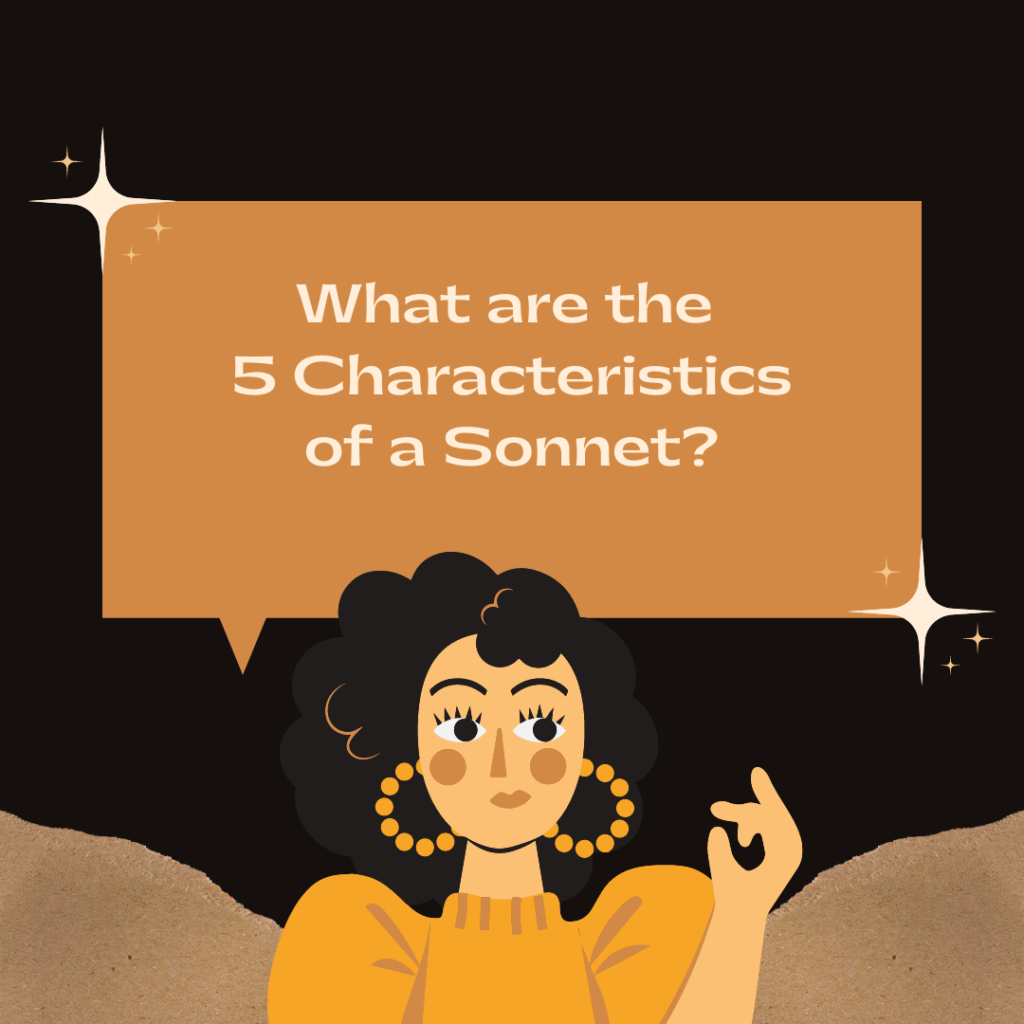
Table of Contents
What are the 5 characteristics of a sonnet?
This is a common question.
Most teachers will tell you that sonnets have three basic characteristics:
- They have fourteen lines.
- They have a rhyme scheme.
- They are written in iambic pentameter.
I like to add two more:
- They develop and solve a conflict.
- They fall into one of four categories–Miltonic, Spenserian, Petrarchan, and Shakespearean.
The Shakespearean and the Petrarchan sonnets are the most popular. Let’s consider each.
Shakespearean Sonnets
The Shakespearean sonnet typically has an abab cdcd efef gg rhyme scheme. The conflict is introduced and developed within the first twelve lines and resolved in the final two, which are called a couplet.
My mistress’ eyes are nothing like the sun;
Coral is far more red, than her lips red:
If snow be white, why then her breasts are dun;
If hairs be wires, black wires grow on her head.
I have seen roses damasked, red and white,
But no such roses see I in her cheeks;
And in some perfumes is there more delight
Than in the breath that from my mistress reeks.
I love to hear her speak, yet well I know
That music hath a far more pleasing sound:
I grant I never saw a goddess go,
My mistress, when she walks, treads on the ground:
And yet by heaven, I think my love as rare,
As any she belied with false compare.
In the first twelve lines, Shakespeare presents the unseemly characteristics of his lady. He develops this portrait with her “black wire hair” and breath that “reeks.” Then notice in the final couplet how he resolves her lack of beauty. He absolves her physical shortcomings because the typical gorgeous lady of poets like Petrarch doesn’t exist. So Shakespeare’s mistress is without comparison and therefore, perfect.
Petrarchan Sonnets
The Petrarchan sonnet has an abba abba octet (the first eight lines) and a flexible sestet (six lines). Usually, the sestet is cde cde. Unlike the Shakespearean sonnet, the conflict is introduced in the first quatrain, developed in the second, and resolved in the sestet.
When I consider how my light is spent,
Ere half my days, in this dark world and wide,
And that one Talent which is death to hide
Lodged with me useless, though my Soul more bent
To serve therewith my Maker, and present
My true account, lest he returning chide;
“Doth God exact day-labour, light denied?”
I fondly ask. But patience, to prevent
That murmur, soon replies, “God doth not need
Either man’s work or his own gifts; who best
Bear his mild yoke, they serve him best. His state
Is Kingly. Thousands at his bidding speed
And post o’er Land and Ocean without rest:
They also serve who only stand and wait.”
In this Petrarchan sonnet by John Milton, we see he introduces the conflict with his blindness in the first four lines. He develops his frustration in the next quatrain as he feels “useless” because he can’t “serve his Maker” well. In the final sestet, he resolves his conflict with God who tells Milton that faith rather than work pleases him.
Summary
So what are the five characteristics of a sonnet? There are three basic characteristics of a sonnet. Most sonnets have fourteen lines, an iambic pentameter, and a rhyme scheme. They fall into one of four categories: Miltonic, Spenserian, Petrarchan, and Shakespearean. Shakespearean sonnets have an abab cdcd efef gg rhyme scheme, while Petrarchan sonnets have an abba abba cde cde rhyme scheme. They key difference between these two styles is how they develop the conflict. A Shakespearean sonnet develops it within the first twelves lines and resolves it in the final couplet. A Petrarchan sonnet, on the other hand, develops the conflict within the first eight lines and resolves within the final sestet.
Sonnet Challenge
Thanks for reading my article about the characteristics of a sonnet! Before you go, I invite you to sign up for my newsletter and check out my podcast, Motivation To Write.





It is so interesting to learn about a sonnet! Pretty cool that there is a structure similar to a haiku. I like that there is a rhyming scheme too. Actually – I totally forgot that they taught this back in Literature class! Thanks for sharing all of these great characteristics of a sonnet.
Nancy ✨ exquisitely.me
Thanks for stopping by, Nancy!
Very interesting article! Thanks for sharing these characteristics of a sonnet.
Thanks for stopping by, Lomash!